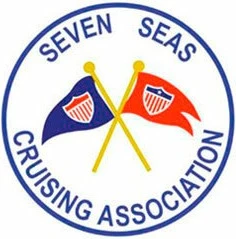
Sometimes anchoring is easy ⎯ stop the boat, lower the anchor, and let out enough rode. But, for those times when you run into troubles, here are some tips and techniques that might ease the frustration.
Hung Up
One way to free a fouled anchor is with a pre-emptively attached trip line ⎯ a line long enough to reach the surface, attached at one end to the back of the anchor, the other end to a float. The idea is that by pulling on the trip line, the anchor will come out backward.
Since a trip line can wrap around skegs, props, rudders, or interfere with the anchor or rode, it is best to install a trip line only when the odds are good that the anchor will get hung up in the bottom.
To minimize the risk of losing the anchor, the trip line should be hefty enough to handle the potential loads, loads that can reach into the hundreds and even thousands of pounds. We use half-inch line, which has a breaking strength of 6000 lbs.; plus, half-inch line is generally considered to be the smallest diameter that's comfortable on the hands, if 'comfort' can be the word to use.
Jammed
On one occasion, our anchor wouldn't break out. We hadn't installed a trip line, and conditions weren't conducive to diving on the anchor. We tried yawing the boat to one side, then the other, and even made full circles, but no success.
We tried patience, hoping that with a strain kept on the rode the waves and wakes would help to free the anchor, but no success with this technique either.
Then we again became pro-active ⎯ we encircled the rode with a 2-3 foot length of chain and secured its ends together with shackles, though a hefty lashing or bolt and nut could have also worked. To this 'chain collar' we attached a half-inch line. After bringing the rode 'up and down', we used this half-inch line to lower this 'collar', sliding it down the rode and the shank of the anchor. Then, with some slack in both the rode and 'trip line', we backed away from the anchor ⎯ the anchor slid right out!
Unwanted Windlass Activity
Damage often results when an electric windlass shorts and activates, either up or down. To avoid inadvertent activation of your windlass, its circuit breaker should be turned off when finished deploying or weighing anchor.
Unfortunately, many circuit breakers are in difficult or inconvenient locations⎯if so, relocate the circuit breaker to a position where it is handy to reach and is easily seen.
Don't Break It
All windlasses have a Work Load Limit (WLL), and for many, this limit is surprisingly low, in the 400-700 pound range. When setting or breaking out an anchor, especially since wind or waves can easily double, triple, or more the load on the windlass, damage to the windlass can result.
To avoid overloading a windlass' mechanism a 'stopper' should be used. Once the stopper is engaged, the rode is slackened to remove any load from the windlass' mechanism.
Stoppers come in two types: hard and soft. A hard stopper is a metal appliance that is bolted to the deck, through which the rode runs. When put to use, all that is required is to flip a lever into place. A hard stopper works only with chain rode, must be aligned properly on installation, and is limited in the direction in which the rode can have a pull on it.
A soft stopper is just a short length of line ⎯ the bitter end made fast to a strong point on the boat and the working end rolling-hitched to the rode. The major advantages with soft stoppers are that their installation is flexible and simple, and are usable with either rope or chain rodes.
Grounded
To avoid an inadvertent grounding when the tide goes out, before letting go the anchor, check depths, not only where the boat will immediately lie, but also where it might swing and adjust the anchor's drop point if necessary.
In dam controlled waterways, increased 'pool' levels may be lowered back to 'normal pool', often without warning. In these waterways, to avoid being unable to leave an anchorage, or inadvertently being grounded while anchored, consider adding this increased 'pool' level to the amount of depth that the boat normally requires.
Bigger Is Better
Depending on its density, mud has from 1/3rd to 1/6th the holding power of sand; thus, if you are going to anchor in mud, your anchor needs to be bigger to have the same holding power as it would have in sand, by at least one size, and two sizes up is even better. Don't skimp, spend the money, go bigger!
It's a Drag
When setting an anchor in soft bottoms, it might take 40+ feet of dragging it before the anchor digs deep enough to start holding. A technique to shorten this distance is 'pull and pause' ⎯ deploy the anchor with adequate rode, pull lightly on the anchor, and then momentarily ease off. Then repeat, slightly increasing rpms on successive pulls. Eventually the anchor will wiggle deep enough to start holding adequately. Wait until this point is reached before being more aggressive with the rpms.
Keep 'er Up
When setting an anchor with a hinged shank, the shank of the anchor can pivot down, ending up below the flukes, inhibiting the flukes from digging in. The solution is to keep the shank up ⎯ set the anchor on a short scope, around 2:1 or 3:1. Once the flukes grab, veer more rode. Don't forget to finish with enough rode to satisfy scope requirements.
Swivels
Jaw/eye swivels have a well-deserved, rotten reputation in anchoring, with good reason: cotter pins fail, jaws can be wedged apart, clevis pins back out, and since a swivel's load rating is reduced by half when side loaded, pivot mechanisms often break. Side loading is particularly at high risk if the jaw of the swivel is attached directly to the anchor, and this is true of all swivels regardless of the material the swivel is made from.
An inexpensive, and commonly-available solution is to use a galvanized eye/eye swivel, thus eliminating cotter pins, clevis pins and jaws. Since an eye/eye swivel requires shackles at each end for attachment to their adjacent partners, this provides for universal movement at both ends of the swivel, making it most difficult to side load the swivel's pivot mechanism. An even greater advantage is that, with the use of shackles, a larger swivel, one with a WLL that equals, or better yet exceeds the chain's WLL can be installed.
G3 vs. G4
To be assured that a shackle will fit and match the WLLs of the chain, choose a shackle manufactured to Federal Standard RR-C-271E, often referred to as '271' or '271E'. For ground tackle, use only screw-pin shackles to prevent the jaws from being forced apart, grease the threads to minimize corrosion, or with stainless steel shackles, galling, and mouse (safety wire) the pins to prevent them from backing out.
However, G3 chain requires different shackles than does G4 chain. With G3 chain, regular-strength (carbon) shackles will fit and match the chain's WLL. But, for shackles to fit and equal in strength G4 chain, high-strength (alloy) shackles must be used.
Though regular-strength 'carbon' shackles are readily available, high-strength 'alloy' shackles are usually more difficult to come by. Local chandleries or industrial supply facilities, if they don't stock them, can often order them. They can also be purchased online from many chain or rigging suppliers, or possibly direct from the manufacturer.
To end, we'd like to point out that this article certainly is not an all-inclusive list of tips for anchoring. Read all of the books on anchoring and remain flexible, open-minded, and inventive. If one idea doesn't work, try another, even if others think it to be 'outlandish' ⎯ if it works, who can find fault!
Purchase "ANCHORING−A Ground Tackler's Apprentice" in the Ship Store.











